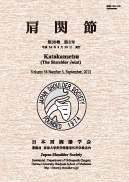36 巻, 3 号
選択された号の論文の85件中51~85を表示しています
筋腱疾患
-
2012 年 36 巻 3 号 p. 995-998
発行日: 2012年
公開日: 2012/10/25
PDF形式でダウンロード (963K) -
2012 年 36 巻 3 号 p. 999-1002
発行日: 2012年
公開日: 2012/10/25
PDF形式でダウンロード (494K)
変性疾患
-
2012 年 36 巻 3 号 p. 1003-1005
発行日: 2012年
公開日: 2012/10/25
PDF形式でダウンロード (383K) -
2012 年 36 巻 3 号 p. 1007-1009
発行日: 2012年
公開日: 2012/10/25
PDF形式でダウンロード (360K) -
2012 年 36 巻 3 号 p. 1011-1014
発行日: 2012年
公開日: 2012/10/25
PDF形式でダウンロード (727K)
その他
-
2012 年 36 巻 3 号 p. 1015-1018
発行日: 2012年
公開日: 2012/10/25
PDF形式でダウンロード (683K) -
2012 年 36 巻 3 号 p. 1019-1022
発行日: 2012年
公開日: 2012/10/25
PDF形式でダウンロード (1219K) -
2012 年 36 巻 3 号 p. 1023-1027
発行日: 2012年
公開日: 2012/10/25
PDF形式でダウンロード (729K)
治療法
-
2012 年 36 巻 3 号 p. 1029-1032
発行日: 2012年
公開日: 2012/10/25
PDF形式でダウンロード (950K)
症例報告
-
2012 年 36 巻 3 号 p. 1033-1036
発行日: 2012年
公開日: 2012/10/25
PDF形式でダウンロード (713K) -
2012 年 36 巻 3 号 p. 1037-1040
発行日: 2012年
公開日: 2012/10/25
PDF形式でダウンロード (424K) -
2012 年 36 巻 3 号 p. 1041-1044
発行日: 2012年
公開日: 2012/10/25
PDF形式でダウンロード (672K) -
2012 年 36 巻 3 号 p. 1045-1048
発行日: 2012年
公開日: 2012/10/25
PDF形式でダウンロード (469K) -
2012 年 36 巻 3 号 p. 1049-1051
発行日: 2012年
公開日: 2012/10/25
PDF形式でダウンロード (563K) -
2012 年 36 巻 3 号 p. 1053-1056
発行日: 2012年
公開日: 2012/10/25
PDF形式でダウンロード (405K) -
2012 年 36 巻 3 号 p. 1057-1061
発行日: 2012年
公開日: 2012/10/25
PDF形式でダウンロード (1258K) -
2012 年 36 巻 3 号 p. 1063-1066
発行日: 2012年
公開日: 2012/10/25
PDF形式でダウンロード (877K) -
2012 年 36 巻 3 号 p. 1067-1070
発行日: 2012年
公開日: 2012/10/25
PDF形式でダウンロード (955K) -
2012 年 36 巻 3 号 p. 1071-1074
発行日: 2012年
公開日: 2012/10/25
PDF形式でダウンロード (424K) -
2012 年 36 巻 3 号 p. 1075-1077
発行日: 2012年
公開日: 2012/10/25
PDF形式でダウンロード (903K) -
2012 年 36 巻 3 号 p. 1079-1081
発行日: 2012年
公開日: 2012/10/25
PDF形式でダウンロード (582K) -
2012 年 36 巻 3 号 p. 1083-1085
発行日: 2012年
公開日: 2012/10/25
PDF形式でダウンロード (729K) -
2012 年 36 巻 3 号 p. 1087-1089
発行日: 2012年
公開日: 2012/10/25
PDF形式でダウンロード (682K) -
2012 年 36 巻 3 号 p. 1091-1094
発行日: 2012年
公開日: 2012/10/25
PDF形式でダウンロード (747K) -
2012 年 36 巻 3 号 p. 1095-1098
発行日: 2012年
公開日: 2012/10/25
PDF形式でダウンロード (893K) -
2012 年 36 巻 3 号 p. 1099-1102
発行日: 2012年
公開日: 2012/10/25
PDF形式でダウンロード (783K) -
2012 年 36 巻 3 号 p. 1103-1105
発行日: 2012年
公開日: 2012/10/25
PDF形式でダウンロード (722K) -
2012 年 36 巻 3 号 p. 1107-1110
発行日: 2012年
公開日: 2012/10/25
PDF形式でダウンロード (862K) -
2012 年 36 巻 3 号 p. 1111-1114
発行日: 2012年
公開日: 2012/10/25
PDF形式でダウンロード (873K) -
2012 年 36 巻 3 号 p. 1115-1118
発行日: 2012年
公開日: 2012/10/25
PDF形式でダウンロード (800K) -
2012 年 36 巻 3 号 p. 1119-1122
発行日: 2012年
公開日: 2012/10/25
PDF形式でダウンロード (424K) -
2012 年 36 巻 3 号 p. 1123-1126
発行日: 2012年
公開日: 2012/10/25
PDF形式でダウンロード (1002K) -
2012 年 36 巻 3 号 p. 1127-1130
発行日: 2012年
公開日: 2012/10/25
PDF形式でダウンロード (597K) -
2012 年 36 巻 3 号 p. 1131-1134
発行日: 2012年
公開日: 2012/10/25
PDF形式でダウンロード (984K) -
2012 年 36 巻 3 号 p. 1135-1138
発行日: 2012年
公開日: 2012/10/25
PDF形式でダウンロード (827K)
